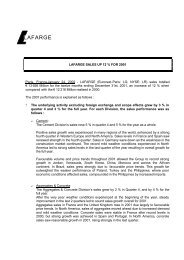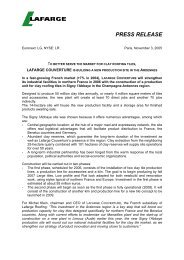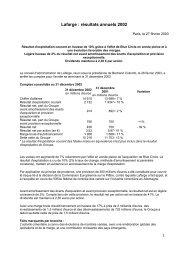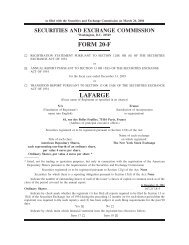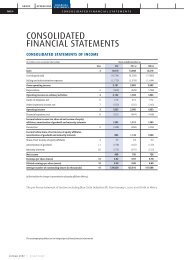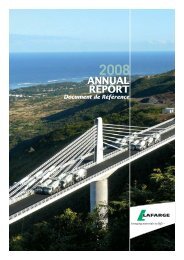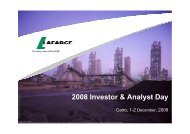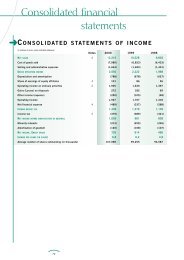2005 Sustainability Report - Lafarge
2005 Sustainability Report - Lafarge
2005 Sustainability Report - Lafarge
Create successful ePaper yourself
Turn your PDF publications into a flip-book with our unique Google optimized e-Paper software.
Assuring our employees' safety<br />
and protecting their health<br />
In terms of safety, the objective of a group such as <strong>Lafarge</strong> cannot be any other than to achieve zero<br />
accidents. Reflecting our ethics and corporate values, safety is a major pillar of our overall performance.<br />
Prevention efforts made under the Group's Health and Safety Policy entail the implementation of<br />
action plans with the involvement of our entire workforce in order to make this not just one of many<br />
priorities, but one of the key values underpinning the Group.<br />
TO RANK AMONG THE TOP<br />
PERFORMERS IN TERMS OF<br />
SAFETY<br />
Even if there is a general improvement,<br />
the Group's occupational safety results<br />
are not yet good enough. Although the<br />
occupational accident frequency rate<br />
and the number of accidents have<br />
declined steadily, two factors temper<br />
the significance of this performance.<br />
> See indicators on page 30<br />
The safety of our subcontractors needs<br />
to be substantially improved, particularly<br />
in transportation activities. Moreover,<br />
the operations that have attained the<br />
highest levels in this area seem to have<br />
reached a plateau. Finally, the level of<br />
risk remains a cause for concern because<br />
the number of fatal accidents increased<br />
during <strong>2005</strong> even if this increase is partly<br />
due to a greater reporting accuracy from<br />
our subcontractors.<br />
> See table on page 42<br />
We need to inject fresh impetus into our<br />
efforts to improve these results and give<br />
ourselves the means to achieve a zero<br />
fatal accident rate. To this end, several<br />
projects were launched or continued<br />
during <strong>2005</strong>.<br />
<strong>Lafarge</strong> continued to roll out its safety<br />
management system. At year-end <strong>2005</strong>,<br />
93% of <strong>Lafarge</strong>'s employees were covered<br />
compared with 88% in 2004.<br />
In China, for example, the implementation<br />
of <strong>Lafarge</strong>’s health and safety standards<br />
played a genuine role in the performance<br />
improvement; enabling performance<br />
levels that can be compared with those<br />
of our best plants. The NanShan plant,<br />
acquired by <strong>Lafarge</strong> in 2002, achieved<br />
the Group’s best occupational safety<br />
levels, in only 3 years, through the<br />
implementation of safety management<br />
standards and a modernization of<br />
equipment (frequency rate: 0.95, severity<br />
rate: 0.34).<br />
The Group's medium-term objectives<br />
were redefined with a new deadline of<br />
2008. They include achieving a zero fatal<br />
industrial accident rate at its facilities,<br />
and halving the accident frequency rate<br />
compared with <strong>2005</strong> (frequency rate:<br />
3.87). In the long term, <strong>Lafarge</strong> wants<br />
to reach a zero fatal accident rate and<br />
an accident frequency rate of less than<br />
1 for its employees and subcontractors.<br />
The Cement business has included in<br />
its Health and Safety Management System<br />
procedures regarding the performance<br />
of its suppliers and contractors. This<br />
‘Contractor H&S Management System’,<br />
which was extended in <strong>2005</strong> to the<br />
purchasing managers of Business Units,<br />
covers safety when the services of<br />
subcontractors are used. It is being rolled<br />
out to all the Group's operations.<br />
Finally, the Group embarked on an<br />
exhaustive survey of safety in September<br />
<strong>2005</strong>. A total of 90 site audits, 20 Business<br />
Unit audits and close to 300 individual<br />
interviews will be carried out across the<br />
Group by mid-2006. The survey will help<br />
to assess safety awareness within the<br />
Group and to prepare a three-year action<br />
program. This major campaign will be<br />
designed to increase the coherence of<br />
the Group's actions and inject fresh<br />
impetus to achieve our objectives.<br />
At the request of the European Works<br />
Council, a survey was carried out in <strong>2005</strong><br />
on the implementation of occupational<br />
health and safety policies.<br />
> See page 33<br />
ZERO ACCIDENT<br />
OBJECTIVE AT LAFARGE<br />
NORTH AMERICA<br />
Dominique Calabrese,<br />
President of <strong>Lafarge</strong> North America's Safety<br />
Council, emphasizes the major role played<br />
by managers and the need for habits to change<br />
to achieve the zero accident objective.<br />
Efforts in North America to mobilize<br />
employees on this issue were concentrated<br />
on three levels: requiring the personal<br />
involvement of senior management in safety<br />
matters, mobilizing supervisory staff and<br />
strengthening interpersonal relationships<br />
so that each employee is aware of high-risk<br />
behavior for his/herself and his/her<br />
colleagues. Safety will be fully integrated<br />
into human resource management<br />
procedures during 2006.<br />
Employee in a plasterboard<br />
plant of <strong>Lafarge</strong> Gypsum<br />
in Germany.<br />
LAFARGE | <strong>2005</strong> SUSTAINABILITY REPORT | PAGE 29




